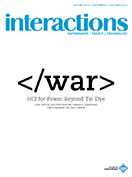Authors:
Katherine Isbister
How do you describe your lab to visitors?
The Game Innovation Lab is an interdisciplinary research and teaching space where we take games as an innovation challenge for advancing computer science and engineering as well as design. We designed the space to be highly reconfigurable, with affordances for creativity and collaborative work, such as white-board walls and scribble-able coffee tables, as well as a more playful "living room" area for meeting and brainstorming. The lab is equipped with state-of-the-art game hardware and software that researchers and students can use to prototype projects.
What is a unique feature of your lab?
Our lab has a unique public presence in the university, because of its wall of large windows looking out into the urban plaza that NYU-Poly calls home. We have a large, 4x6 monitor display wall that faces out onto the plaza that we use to run public games and other installations. We recently hosted part of the World Science Festival both inside and outside the labthe space design makes this mixing of exterior and interior possible, allowing us to try out ideas for engaging the public.
How many people are in the lab, and what is the mix of backgrounds and roles?
We typically have 10 to 15 graduate researchers with access to the lab, working on active projects, led by four participating faculty sponsors. Three of these faculty members are from the computer science department, and one is from electrical engineering. The students come from these departments as well as digital media at Poly, and we also have students involved in the research from other schools of NYU, including the Tisch School of the Arts, the Gallatin School, and the Steinhardt School. Plus, we have an artist in residence.
The lab hosts two to three courses each terma mix of CS courses, such as mobile app development and HCI, and games-related digital media courses, such as game development. These are primarily graduate courses, but we do get a handful of undergrads in the lab, too.
Briefly describe a day in the life of your lab.
Our lab manager and IT person arrive around 9:30 am, and might find a grad student asleep in the user research lab after a long night of coding. Grad students come and go throughout the day and evening, meeting and working together and in parallel at their desks and in the living room. We often have play tests and user research going on in our soundproof user research lab (which is equipped to record and mix video and audio from a large display, as well as from three wall-mounted cameras, and can stream this live to remote viewers if needed). On a typical day there might be one class running in the afternoon or evening. Often our artist in residence is around working on her games and chatting with students about their projects. The faculty drift in for student check-ins and group meetings, and there seems to be at least one impromptu VIP tour a week, as Poly is proud of the space and likes to show it to visitors. Some days we will have a public lecture happening in the evening, in which case we quickly rearrange the classroom area of the lab into a more seminar-style layout. Everything has wheels, so it's easy to reconfigure.
What is one feature of your lab you could not do without?
Before we created the lab, we did a space-planning workshop with help from the guys who planned out space at the Stanford dSchool. Grad students told us they pined for natural light in their everyday workplace. The windows we designed into the plans have really transformed this space, and we would all be very sad not to have the daylight and the view of the trees in the plaza.
What is one feature of your lab that you want and don't have?
Students sometimes wish for a laser cutter and other physical prototyping tools.
How would you describe how people interact in your lab?
Designing the space to encourage creativity and teamwork seems to have been a success; the living room in particular is a site of informal conversation and play that helps drive collaboration across disciplinary and research-group lines. Though people do sit at desks and do individual, focused work some of the time, they also regularly gather and trade notes, and are free to plug a laptop into the big screen to share an idea or host a quick, informal play test. Furniture moves around regularlythe students feel comfortable editing the space as needed, which I believe allows them to think more creatively and flexibly as they build and test ideas.
What is the one thing you see as most important about what you do here?
Building playful experiences and innovating their technological underpinnings requires deep expertise and collaboration across many disciplines, and an environment in which it is easy to experiment and test out ideas. I believe the Game Innovation Lab has been designed well to support this way of working.
©2012 ACM 1072-5220/12/0900 $15.00
Permission to make digital or hard copies of all or part of this work for personal or classroom use is granted without fee provided that copies are not made or distributed for profit or commercial advantage and that copies bear this notice and the full citation on the first page. To copy otherwise, to republish, to post on servers or to redistribute to lists, requires prior specific permission and/or a fee.
The Digital Library is published by the Association for Computing Machinery. Copyright © 2012 ACM, Inc.










Post Comment
No Comments Found